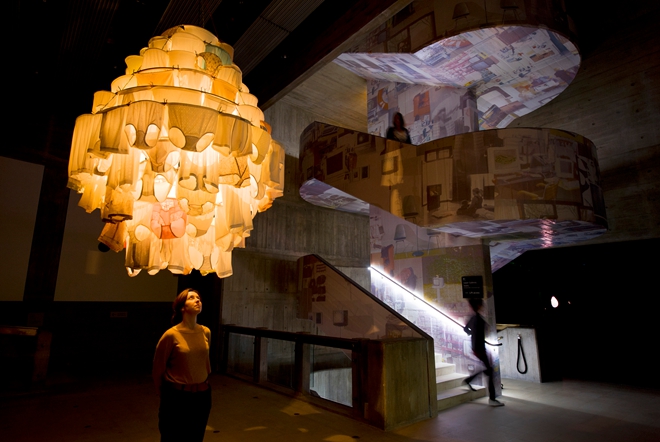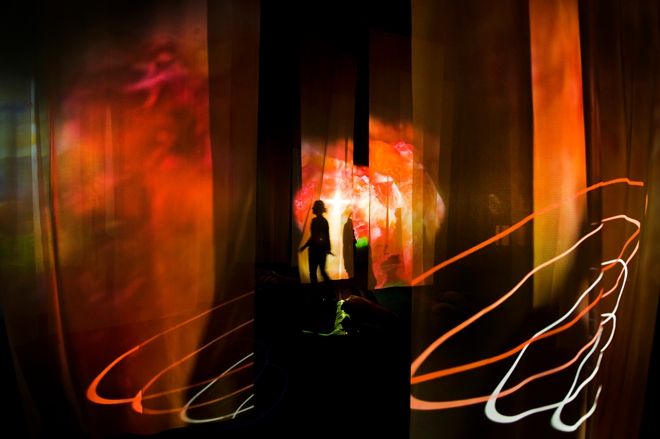How was it for you? “Moving Image in China,’” I mean. Did you enjoy it?
Perhaps “enjoy” is not the right word”… We were interested — but not necessarily amused.
Minsheng’s survey was a momentous, systematic show of video art, much of it both historic and remarkable. Check. Chinese artists have done much to involve themselves with this medium. Check. Beginning with Zhang Peili’s “30×30” (1988), the show orchestrated a chronological tour through over 50 works by over 30 artists. Check. Some aspects were moot: the exhibition’s inclusiveness, for example, because according to the Book of Minsheng, “China,” means largely the mainland, and on the flip side, one needn’t quibble over the distinction between video artists and artists who happen to have made a video work. Not to mention – as Phil Tinari recently let slip — “‘mini-scandals’ over things like whose work was projected versus played on a screen…”(1)
But in hindsight, scope, scale and egos aside, something that resonated with a visit to this show — and which escaped the reviews — was its lack of…how to put it? Pleasure. These videos are sober: amongst this myriad of screens nestled precious little visually or otherwise to tease or amuse. This is not to say the show lacked imagination (courtesy of film-festival darling Sun Xun), quirkiness (the ever-wacky Hu Xiangqian) and — “oooh! androgènes stalking through the woods in golden bondage gear!”— offbeat eroticism (Huang Ran). Sure, it was a rare privilege to see Qiu Zhijie’s fun-packed “Washroom” (1995), and one can but be absorbed by Ma Qiusha’s jolly razor-blade monologue of 2007. But who could claim for “Moving Image in China…” the ability to relax, titillate or beguile its audience? Yang Fudong’s slick sequences are, by a certain cinematic osmosis, seductive; a whole ground floor area was devoted to them — perhaps unwittingly to provide a more sensuous (if slightly gormless) monochrome endnote. But where was the FUN! — the invitation to unburdened absorption, visual abandon before moving imagery? Do we wish merely to bathe in the beam of the black box? No. It’s just that on exiting Minsheng’s darkened halls, one was left impressed by the absence of certain moods — playfulness, buoyancy, sanguinity — in Chinese video art. Champagne, anyone? Let’s now take a moment to appreciate the palpably outré title of Pipilotti Rist’s most recent exhibition at London’s Hayward Gallery: “Eyeball Massage.” It’s a heading ripe for Rist’s oddball visual viscera. Born Elizabeth Rist in 1962 (she changed her name to “Pipilotti” after the anarchic protagonist of Astrid Lindgren’s beloved 1945 children’s book “Pippi Longstocking” (2)), the Swiss artist has since the 1980s been pursuing her desire (as quoted in the Hayward pamphlet) to “discover new ways of configuring the world, both the world outside and the world within,” through video. She has won wide acclaim as an inventive choreographer of psychotropic, mellifluously coloured and bodily-charged imagery. Rist’s breakthrough came with “Ever is Over All” (1997), a slow-motion film of her skipping gaily down the street in a cutesome dress, smashing the windows of parked cars with a giant fake tropical tulip; a policewoman nods in greeting as the artist gambols merrily past… Back at Minsheng, we were wondering if our drinks would last the course.![展览场景: Pipilotti Rist: "眼部按摩", Hayward 画廊。 "Administrating Eternity" (2011). [摄影: Linda Nylind]](https://www.randian-online.com/wp-content/uploads/2012/03/pr11-245x245.jpg)

